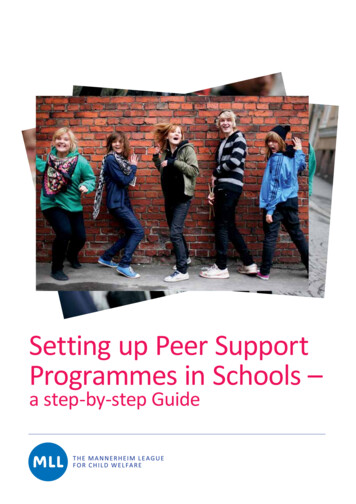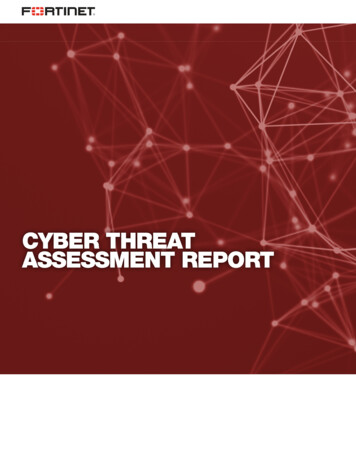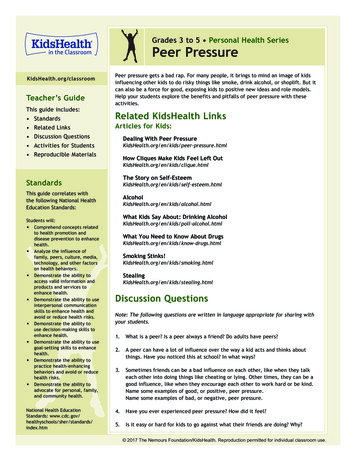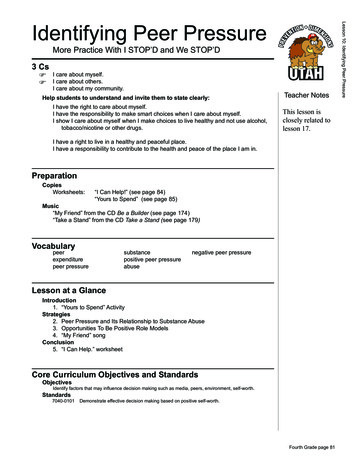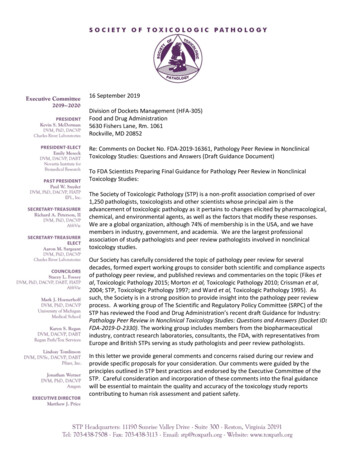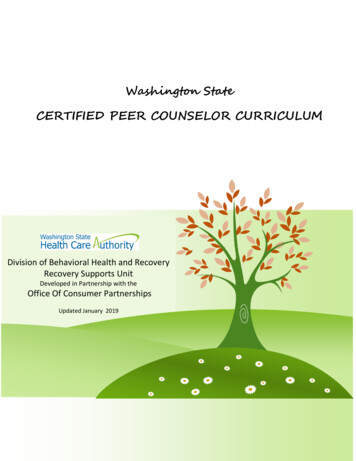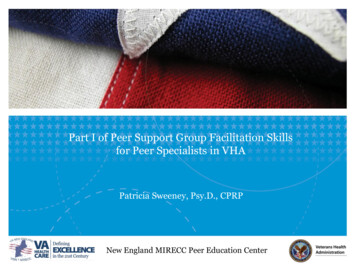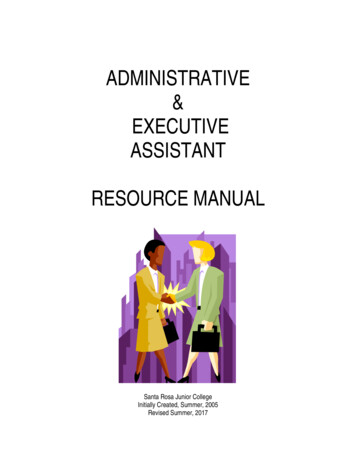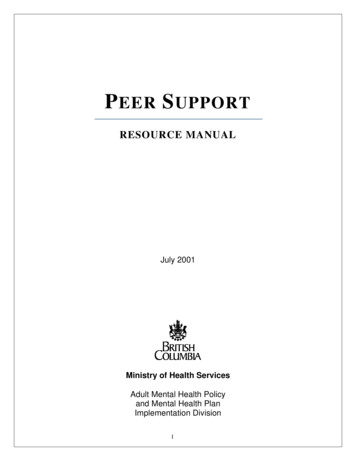
Transcription
P EER S UPPORTRESOURCE MANUALJuly 2001Ministry of Health ServicesAdult Mental Health Policyand Mental Health PlanImplementation DivisionI
This peer support manual reflects the efforts of nine committee members fromacross the province. The group was composed primarily of people who haveexperienced mental illness and a few service providers; all are active in the area ofpeer support.The committee oversaw the research, writing and production of this manual whichwas carried out by the CMHA - B.C. Division Consumer Development Project inKelowna and the Research, Education, Evaluation and Support Centre (R.E.E.S.) ofthe Capital Health Region in Victoria, two consumer-based organizations.The Ministry of Health is grateful for the expertise and diligence these individualsbrought to the work.This Manual was published with the support ofthe British Columbia Ministry of Health,Adult Mental Health Policy Division
ACKNOWLEDGEMENTSWe thank all the consumers, family members, service providersand mental health managers who believed in Peer Supportenough to develop programs in their regions. These programshave paved the way for peer support to become a core part ofservices for people with mental illness.Thank you to Pam Rosenbloom, who started us on the path.We have read and incorporated portions of material andphilosophiesof different peer support programs which are in existence inBritish Columbia.A special thank you to these programs:Victoria’s Capital Health Region Peer Support (R.E.E.S.)Vernon’s Peer Outreach ProgramVancouver’s Peer Support ProgramSouth Fraser Health Region’sMennonite Central Committee Peer Support ProgramRichmond’s Peer Support ProgramMid Island’s (Nanaimo, Parksville)Canadian Mental Health Association Peer Support ProgramLangley’s Stepping StonesKelowna’s PEPtalkIII
TABLE OF CONTENTSExecutive Summary. 1Preamble . 3Section 1INTRODUCTION . 6Purpose of the Peer Support Resource Manual. 8History Behind Peer Support Resource Manual. 9Definitions. 11Fundamental Values of Peer Support. 11Basic Assumptions about Peer Support. 12Classifications of Peer Support . 12Mutual Support – Informal Structure. 12Trained Peer Support – Moderate Structure . 13Trained Peer Support – Formal Structure . 13Trained Peer Support/Complementary toClinical Team – Formal Structure . 14Section 2KEY ELEMENTS OF PEER SUPPORT .15Table 1 - Comparison of Classifications ofPeer Support . 16Key Elements of a Mutual Support Program– Informal Structure Program . 18IV
Key Elements of a Trained Peer Support– Moderate Structure Program . 20Key Elements of a Trained Peer Support– Formal Structure Program . 22Key Elements of a Trained Peer Support– Complementary to Clinical Team –Formal Structure Program . 26Section 3TRAINING CURRICULUM – KEY ELEMENTS.30Length of Course. 30Format of Presentation. 30Course Content . 31Table 2 - Training Curriculum - Key Elements. 32Section 4STEPS TO IMPLEMENTING A PEER SUPPORTPROGRAM .35Defining the Purpose of thePeer Support Program . 35Developing a Steering/Advisory Committee . 36Membership of Committee. 36Defining the Roles and Responsibilities of theSteering Committee in Setting up the Program. 37Assessing Available Resources . 37Financial Resources . 37
Human/Leadership Resources . 37Developing the Mandate of the Program . 38What are the Age Limits? . 38Who Refers Consumers/survivors? . 38What are the Criteria for Consumers/survivors to beAccepted into the Program?. 38What is the Time Period of Support? . 39What Policies and Procedures are Needed? . 39Developing a Job DescriptionFor the Coordinator(s) . 40Developing a Process for AcceptingPeer Supporters into Training. 41Developing a Process for SelectingPeer Supporters . 42Developing the Responsibilities of theBookkeeper . 42Evaluating the Program. 43Section 5SPECIAL ISSUES FOR CONSIDERATION .45Employment Standards Act. 45Volunteer vs. Employee . 45Table 3 – MATRIX: Regulation, Section 32:Employees Excluded from the Act. 47Minimum Labour Standards . 50Possible Loss or Decrease in Income Benefits . 51B.C. Disability Benefits II . 51Canada Pension Plan Disability Benefits. 51
Union Relations. 52Job Protection. 52Pay Scales . 52Peer Supporters Providing Support from the Unitwhere they Receive, or Once Received, Services . 53Concerns of Peer Supporters Providing Support . 53Concerns of Consumers/Survivors ReceivingSupport . 54Concerns of Management/Professional ServiceProviders . 54Characteristics of Professionals Working withPeer Support Programs . 55Conditions that Need to be Pre-Existing in theMental Health System. 55Awareness Needs to be Cultivated by . 55Skills that Need to be Practiced. 55Funding . 56Section 6PEER SUPPORT IN OTHER FORMATS .57Seniors’ Peer Support . 57Multi-Cultural Peer Support. 57Warm Lines . 58Internet Peer Support Chat Lines. 58Section 7APPENDICES .59
Appendix 1 - Oath of Confidentiality. 61Appendix 2 - Application for Training . 62Appendix 3 - Referral Letter from a Professional . 64Appendix 4 - Interview Questions – Pre Training. 65Appendix 5 - Interview Questions – Post Training . 68Appendix 6 - Referral Form. 70Appendix 7 - Posting for Peer Supporter Position . 71Appendix 8 - Contract, Letter of Agreement . 72Appendix 9 - Orientation to Health Unit . 73Appendix 10 - Activity Log. 75Appendix 11 - Goal and Outcome Sheet . 76Appendix 12 - Hospital Visit Record . 78Appendix 13 - Release of Information Form . 79Appendix 14 - Job Description for Coordinator. 80Appendix 15 – Interview Questionsfor Coordinator . 83Appendix 16 – Time Sheet. 85Appendix 17 – Evaluation ToolsA. Peer Support Training (Classroom) Evaluation . 86B. Peer Support Training (Practicum) Evaluation . 87C. Evaluation by Consumers Referred to Program . 93D. Evaluation by Referral Source(if not self referred) . 94Appendix 18 – Summary of Recommendationsfrom the Consumer Involvement in theWorkplace Report. 99Peer Support Resource Manual References.107
Section 8PEER SUPPORT RESOURCE INVENTORY . 111Peer Support Outreach Research Project . 112Regional Map of Peer Support Programs in B.C. 113Features of Peer Support Programs WithinEach Region . 114Features of Peer Support Training Programs asApplied To the Four Categories ofPeer Support . 119Peer Support Programs in B.C. Regions . . 120Listing of Organizational Support GroupsThroughout Regions. . 151
EXECUTIVE SUMMARY"A full spectrum of mental health services includesoutreach, clinical treatment, crisis response, housing,rehabilitation services, family and community support,case management, advocacy and peer support." (MentalHealth Guidelines for Rehabilitation Services, 1996. pg.6)The Peer Support Resource Manual is the result of work by a Peer SupportResource Committee, an intensive literature search and feedback from a survey ofthe health regions in B.C. about their peer support services.The manual contains background information on the importance of peer supportfor people with a mental illness, key elements needed in a peer support programand a step-by-step outline of how to develop a peer support program. The finalpart of the manual is a database containing the responses to the survey that wassent out by the Research, Education, Evaluation and Support Centre (R.E.E.S.),and a list of the current peer support programs available in the province.The Peer Support Resource Committee developed four main classifications of peersupport programs: Mutual Support - Informal Structure;Trained Peer Support - Moderate Structure;Trained Peer Support - Formal Structure; and ,Trained Peer Support - Complementary to Clinical Team - Formal Structure.These programs are defined and key elements for each are outlined.The manual briefly discusses other forms of peer support, such as: Seniors’ Peer Support;Multi-cultural Peer Support;Warm Lines; and,Internet Chat Lines for Peer Support.Peer support is recognized as a necessary component of a full spectrum of mentalhealth services. Peer support programs operate at their optimum level whensufficient funding is in place.1
“The involvement and empowerment of the individual is an essential part ofeffective rehabilitation services.” (Mental Health Division Guidelines forRehabilitation Services, 1996. pg. 7) Peer Support programs, as part ofrehabilitation, need to fully involve the peer support team members in all aspectsof decision making and the operation of the program.Health Authorities and regional staff need to be aware of how the EmploymentStandards Act impacts on Peer Support programs. Compliance with the Act ismandatory to avoid liability issues. We included a section in the manual whichaddresses this issue.It is our hope that this manual will provide Health Authorities and consumergroups with guidelines for developing excellent Peer Support programs across theprovince. If you have any further questions or concerns please contact:Adult Mental Health Policy DivisionMinistry of Healthrd3 Floor, 1520 BlanshardVictoria, B.C. V8W 3K2Tel: 250 952-1629Fax: 250 952-16892
PREAMBLEThe success of mental health reform, ultimately, will be measured in a number ofways, including the number of people with mental illness who ‘recover’ and attainan optimal level of wellness. The psycho-social rehabilitation and recoveryapproach is therefore the underpinning philosophy of mental health reform.Recovery is “a deeply personal, unique process of changingone’s attitudes, values, feelings, goals, skills and/or roles.It is a way of living a satisfying, hopeful and contributinglife even with illness caused limitations.” 1Some basic assumptions of a recovery-oriented mental health system2 are that: Individuals living with mental illness [may] need support to lead personallysatisfying, hopeful and contributing lives;Recovery from mental illness can occur even though symptoms of illnessreoccur; recovery is not a linear process but it is unfolding and on-going;Recovery assists individuals to reduce symptoms’ frequency and duration;Recovery assists individuals to deal with losses and consequencesassociated with mental illness;Recovery requires recruitment and involvement of people who believe inand assist individuals to pursue their hopes and goals; and,Recovery requires dedicated human and fiscal resources.An important goal of psycho-social rehabilitation and recovery is to provideprograms and services that are recovery-oriented, and are culturally,geographically and gender relevant. Rehabilitation strategies in mental healthreform aim at encouraging client recovery, competency and empowerment. Thisentails taking an individual approach to assess and decide with eachconsumer/survivor what rehabilitation services are most appropriate for theconsumer/survivor’s specific rehabilitation needs. There is no expectation that anindividual must enter at the initial stage or move through these stages in a stepby-step fashion. Rather, services must be planned on an individual basis, witheach individual’s initial entry being at the point most appropriate to personal needsand circumstances.1Psycho-social Rehabilitation and Recovery – Summary. Document presented at the Consultation Forum on Provincial BestPractices in Mental Health: “Doing What We Know Works Best”. Adult Mental Health Division, Ministry of Health. 1999.2Ibid.3
Rehabilitation services are described as a series of stages or categories, namely: Basic support Rehabilitation readiness Rehabilitation process Ongoing cessOngoingSupportRehabilitationReadinessFIGURE 1: REHABILITATION SERVICES3Services must be flexible so that the individual has the opportunity to re-enter atthe same or a different phase, depending on his/her personal needs and goals.4Providing and receiving peer support stands as an integral component ofrehabilitation and recovery for people with mental illness. Peer support initiativescan flexibly occur at any stage of the rehabilitation spectrum described above.The concept of peer support relates to the creation of an interpersonal context thatis respectful, trusting and warm, allowing individuals to find their own answers andempowering them to make changes that will enhance their lives. Roles of peersupporters can relate to helping individuals understand and manage their illness,providing emotional support, helping individuals follow through on goals and actionplans, advocating for individuals, helping individuals re-establish social networks,decreasing isolation of individuals and teaching interpersonal skills.Potential benefits of peer support for consumers/survivors include: individualempowerment, increased self-esteem for individuals who are peer supporters,improved education and employment status, positive changes in the attitudes ofmental health professionals toward the abilities of people with mental illness, anda reduced number of hospitalizations.34Mental Health Division Guidelines for Rehabilitation Services. British Columbia Ministry of Health. 1996.Mental Health Division Guidelines for Rehabilitation Services. British Columbia Ministry of Health. 19964
People who are likely to be successful peer supporters are those who haveaccepted their psychiatric disorder, have a positive attitude toward mental healthprofessionals, have developed effective coping skills and strategies for dealing withstress, like working with people, and can accept individual differences and learnfrom others. They have good interpersonal skills themselves, a personal sense ofself-worth in a team setting, adequate literacy skills and problem solving abilities,are motivated and are generally stable in their personal life.5In this manual, peer support programs in B.C. have been organized according todegree of structure (low, moderate and high). While programs vary, they share acommon purpose. They need to be designed/strengthened with appropriatesupports that promote recovery for those who provide peer support and those whoreceive it. This, according to the nature of psycho-social rehabilitation, must, bydefinition, be individualized.The Ministry of Health considers peer support to be an important contributor torecovery for most people with mental illness. Therefore, the Ministry will workwith Health Authorities to increase the quality and quantity of peer supportservices for people with mental illness.In the past, some people felt the Employment Standards Act (ESA) andRegulations impeded their ability to develop or expand a peer support program.Specifically, issues regarding compensation, work/activity schedules andemployment status for peer supporters were difficult to interpret within theframework of the Act and Regulations.In this manual, the assumption is that programs exist in a variety of forms. Forpeer supporters engaged in the different types of programs described in thismanual, peer support could serve in a variety of purposes: social support, trainingfor employment, and part-time or full-time employment. In order to ensurecompliance with the ESA and avoid potential for employer liability, the goals ofpeer supporters must be assessed and their involvement with the programevaluated flexibly and on an individual basis.5“Best Practices: B.C.’s Mental Health Reform; Psycho-social Rehabilitation and Recovery”.British Columbia Ministry of Health and Ministry Responsible for Seniors. 2000.5
Section 1 INTRODUCTIONThe Ministry of Health and Ministry Responsible for Seniorsdeveloped the 1998 Mental Health Plan – “Revitalizing andRebalancing British Columbia’s Mental Health System”.“This [Mental health] plan provides aframework to guide the work of healthauthorities in evolving mental healthcare systems which will help peoplewith mental illness and their supportnetworks access the services theyrequire to restore and maintainoptimal functioning and health.”(The 1998 Mental Health Plan; pg. iv)Working together to develop ideas.Current evidence suggests thatself-help, in its broadest form,should be a part of any mentalhealth reform strategy. Publiceducation should be a priority inorder to raise self-help as acommunity option.” (Review ofBest Practices in Mental HealthReform, prepared for theFederal/Provincial/TerritorialAdvisory Network on MentalHealth; 1997; pg. 81)The plan contains a list of the HealthMinistry responsibilities and commitments.One of the commitments is to:“ work with health authorities to ensure theparticipation of mental health advisorycommittees and the availability of a rangeof consumer and family initiatives whichsupport involvement, information,education, training, self-help, mutual aidand peer support programs.” (pg. 33)Section 1 - Introduction6
In B.C., a number of communities, including Langley, Kelowna, South Fraser,Richmond, Vancouver, Vernon and Victoria have spent time, effort and resourcesto develop peer support programs. These areas, with their forward-thinkingconsumers/survivors and mental health professionals, have generated a groundswell of interest in the substantial benefits of peer support programs.Peer support is a new initiative that deserves to be considered. One of the majorchallenges to developing a peer support program is making sure it conforms to theEmployment Standards Act. Each peer support program needs to assess theemployment status of all peer supporters. The Vancouver Community MentalHealth Services did ground breaking work in this area. In 1998 VancouverCommunity Mental Health Services worked with consumers, family members,service providers, management and health services’ unions to develop a processfor involving consumers in the workplace.In order for peer support to be effective, everyone involved should recognize thatconsumers are capable of participating and should be an integral part of their ownrecovery process.The people responsible for managing mental health services in the health regionsplay a key role in the development of peer support programs.Section 1 - Introduction7
Purpose of the Peer Support Resource Manual“[Peer support]has helped me tohave hope andfaith. [Peersupport] hashelped in myoptimism towardlife again andhas helped mecope successfullywith familymatters andmany others.”Quote from aconsumer whoreceived peersupport.The Peer Support Resource Manual is intended for use as atool by health authorities and by consumers and families, toidentify key elements of peer support programs for theircommunities. Programs described in the manual areexamples of peer support programs. Each program has itsown strengths and merits, and none is deemed to be betterthan another. Programs should be developed by eachregion according to specific regional needs. The manualincludes: Information useful in assisting the development and/orevaluation of peer support in health regions andcommunities. Information for consumers and consumer groups toexamine and use when making proposals to their localmental health authority or agency to develop a peersupport program. A database of current peer support programs.8
History Behind the Peer SupportResource ManualIn the spring of 2000, the Adult Mental Health Policy Division provided limited,one-time funds to examine peer support in the province. Representatives fromaround B.C. were involved to find an effective way to develop peer support.A time-limited Peer Support Resource Committee was formed to identify keyelements featured in different models of mental health peer support. Thecommittee has guided the creation of this Peer Support Resource Manual.The committee developed and distributed a survey to assist in identifying theexisting peer support programs and those being planned. (The survey used isincluded in the database section of the manual.) At the same time, a literaturesearch regarding peer support was carried out.The Peer Support Resource Committee included representation fromconsumers/survivors and service providers involved in peer support and/oradvocacy organizations in communities around the province and from the Ministryof Health. The Committee met in person and via teleconference during thedevelopment of this manual. The members of the Peer Support ResourceCommittee were: Jill Stainsby, Consumer Support Worker - Vancouver Community MentalHealth Services;Charly Sinclair, CMHA-B.C. Division Consumer Development Project,South Okanagan Co-facilitator;Ron Nichol, Consumer Advocate - North Okanagan;Ray Langley, Peer Support Worker - Williams Lake;John Knight, Peer Support Worker - Prince George;Penny Keene, Consumer Coordinator, Richmond Peer Support Program;Jim Draper, Executive Director, CMHA Mid Island Branch;Anne Bowles, Manager, Consumer and FamilyInvolvement - Capital Health Region; and,Victoria Schuckel, Ministry of Health, Adult Mental Health Policy DivisionLiaison.Section 1 - Introduction9
The responsibility for writing the resource manual and developing the databasewas contracted to R.E.E.S. (Research, Education, Evaluation and Support Centre)in Victoria and the CMHA – BC Division Consumer Development Project (CDP) inthe Okanagan.Section 1 - Introduction10
DefinitionsThere are many definitions of peer support. For clarity, the Committeerecommends that for the purpose of this document, we use the followingdefinitions:Peer Support – is a process in which consumers/survivors offer support totheir peers. Peer supporters experience their own mental health issues andtherefore are in a unique position to offer support to others in order to improvethe quality of their lives.Consumer/Survivor – is a person with direct and personal experience of amental health issue and who has used or is using the resources availablethrough the private or public mental health system. (From B.C.’s Mental HealthReform Best Practices, Consumer Involvement and Initiatives)Fundamental Values of Peer SupportThe committee developed the following list of basic values andcharacteristics of peer support. Each region or community may wishto develop its own set of values and characteristics. Peer support includes all necessary activities and actions that helpimprove/enhance another consumer’s/survivor’s recovery ofquality of life and ability to cope with daily life and set and achievegoals. Individual requirements vary but activities may includegoing for walks, shopping, help with completing forms, etc. Peer support is a helping relationship between consumers/survivorsthat promotes respect, trust and warmth and empowers individualsto make changes and decisions to enhance their lives.Section 1 - Introduction11
Basic Assumptions about Peer Support Peer supporters are consumers/survivors;All people with mental illness, like the general population, have diversity inskills, characteristics, talents and abilities;Not every consumer/survivor has the stability and ability to be a good peersupporter;Not every consumer/survivor wants to be a peer supporter or to be involvedwith peer support;Professional support/input needs to be available when requested; and,The mental health system needs to fund peer support adequately.Classifications of Peer SupportThere is generally a continuum that develops inthe community for peer support. Peer supportcan be as basic as consumers having coffee withconsumers and talking about their lives. Peersupport can be as extensive as consumers beingpart of the mental health team, helpingconsumers set and meet goals. In order toensure clarity, we have created four classificationsof peer support that are described below. It isimportant to recognize all methods of peersupport.“Overall, respondentsindicated that beinginvolved in self-help hada salutary effect on theirquality of life, includingtheir general lifesatisfaction.”(Chamberlain, et al;Winter 1996; pg. 40) Mutual Support -Informal StructureA Mutual Support – Informal Structure program is characterized by mutualaid, social and recreational companionship that are provided through self-helpgroups and one-on-one support. Everyone involved is a volunteer.Confidentiality is a basic requirement. The structure respects consumer choices,is flexible and easily accessible. The program may have a facilitator. No formaltraining is required and the format meets individual needs.This type of peer support requires no specific financial supports; typicallypeople, pay their own expenses and meet at a location agreed upon by theSection 1 - Introduction12
group.Key components are: no formal training and a focus on mutual aid andcompanionship. Trained Peer Support - Moderate StructureA Trained Peer Support - Moderate Structure program provides basicsupport, usually in a group format. The group has a basic structure and atrained facilitator. The facilitator is a volunteer and usually follows themandate, procedures and training policies of the agency he/she represents(e.g., Mood Disorders Association (MDA), British Columbia SchizophreniaSociety (BCSS), and Canadian Mental Health Association (CMHA)).Reimbursement for expenses and/or incentives may be provided. Somefunding may be required for rental of meeting space, refreshments for socialevents, and basic administration needs (posters, newsletter, etc.).Key components are: a trained facilitator and a basic structure. Trained Peer Support - Formal StructureA Trained Peer Support - Formal Structure features extensive screening ofpeer supporters, formal support and coordination, and ongoing education.There are policies and procedures in place. The program has a definedmandate and mission statement and various forms of financial incentive. Teammeetings provide support to the peer supporters. The program is valued andaccepted by regional or mental health services.Annualized funding for this program is required for training, financial incentivesand program administration, which includes a coordinator.Key components are: screening, support and coordination of peer supporters.Section 1- Introduction13
Trained Peer Support/Complementary to Clinical Team –Formal StructureA Trained Peer Support/Complementary to Clinical Team – FormalStructure program is characterized by a formal structure, policies andprocedures. Referral and training are required for peer supporters. Apracticum is also a component of the program. Members of the mental healthteam staff provide supervision. Peer Supporters are engaged part-time by amental health team at an hourly rate for a maximum number of hours perweek.Key components are: peer supporters are complementary to the mentalhealth team, and work from the mental health center/unit.Formal, standardized, written records on each consumer/survivor are requiredfrom the peer supporter. Annualized funding is required for a coordinator,training, contracts, program administration and staff coordination. (SeeSection 2 - Table 1 - Comparison of Peer Support Key Elements, ByClassification.)Peer support programs should not be viewed as static entities, but as flexibleprograms that reflect the changing complexion of the individuals and communitieswhere they are located.Peer support is an enhancement of existing mental health services. Peer support isnot intended to replace any existing mental health services, but rather is anopportunity to enrich the provision of mental health services through the directparticipation and expertise of consumers. Many mental health sectors recognize thevalue of peer supporters and are making attempts to accommodate and promote peersupport.14
Sect
Internet Chat Lines for Peer Support. Peer support is recognized as a necessary component of a full spectrum of mental health services. Peer support programs operate at their optimum level when sufficient funding is in place. 2 "The involvement and empowerment of the individual is an essential part of
